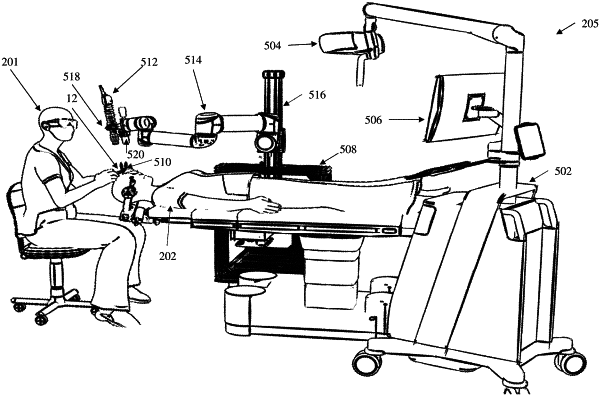| CPC A61B 34/20 (2016.02) [A61B 90/14 (2016.02); A61B 2034/2055 (2016.02); A61B 2034/2065 (2016.02); A61B 2090/373 (2016.02); A61B 2090/3735 (2016.02); A61B 2090/3937 (2016.02)] | 20 Claims |

|
1. A medical navigation system for automatically detecting movement of a subject, the system comprising:
a tracking system, the tracking system comprising at least one tracking device, the at least one tracking device configured to couple with a distinct end effector of a plurality of distinct end effectors;
an intelligent positioning system automatically adjusting position of the tracking device, the intelligent positioning system comprising an automated arm, a lifting column, and the plurality of distinct end effectors, the automated arm comprising a distal end adapted to couple with the plurality of distinct end effectors in one of switching among, independently using, and collectively using a plurality of distinct imaging instruments, the plurality of imaging instruments comprising a plurality of cameras, the plurality of cameras monitoring at least one muscle of the subject throughout a medical procedure, the at least one muscle comprising at least one appropriate muscle related to the medical procedure, and the position of each camera of the plurality of cameras automatically adjusted to perform one of: maintain the at least one appropriate muscle within a field of view of the camera and focus on at least one different muscle when so directed; and
a controller electrically coupled with the tracking system, the controller comprising a processor coupled with a memory, the controller configured to:
receive a data signal from the tracking system;
recognize and continuously monitor a plurality of tracking markers disposed in relation to the subject within each field of view of each camera;
provide an alert when movement of the tracking markers, disposed in relation to the subject, falls within predefined parameters, the predefined parameters indicative of a patient event signifying a physiological state of the subject that is of concern; and
at least one of: differentiate a muscle movement comprising a twitch from other muscle movement by determining whether at least one of a frequency and a magnitude of the muscle movement respectively exceeds at least one of a frequency threshold and a magnitude threshold of the other muscle movement, use machine learning and facial analysis software, the facial analysis software comprising an object and facial recognition engine, and use constructive feedforward neural networks for facial expression recognition,
wherein the intelligent positioning system, the tracking device, the automated arm, and the tracking markers form a feedback loop, and wherein the feedback loop maintains a distal end of a port in constant view and in focus in relation to each distinct end effector.
|